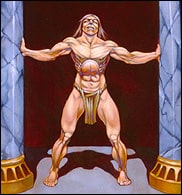The invention of the stirrup brought horsemen into a general shock and close combat role. Keep in mind, that the apex horse army of all time, The Mongol Horde, while initiating battle with composite bows, employed heavy shock troops to break an enemy with a charge delivered from behind a screen of archery. Additionally, Mongolian archers, for whom wrestling was a sport, were powerful men who used heavy cleaving swords, axes and maces, stormed city walls and were feared in close combat.
Likewise, Attila the Hun wielded a rare metal Sword of War and his people practiced wrestling and knife fighting from horseback. While we, in our sissy tower, wish to only study Asiatic horsemen as archers, they were much more, and as terrible as it was to be harried and slaughtered by them from afar, to come to grips with them was worse.
Cross & Crescent
Charles “The Hammer” Martel and his foot soldiers stopped and broke the light horsemen advance into Europe at Tours by fighting close and taking cover behind shields. As the Crusades were launched from Spain to the Near East from Charlemagne’s invasion of Muslim Spain, through the disaster at Nicopolis in 1398 [effecting the slaughter of one of the 4 generations of French knights that would be lost in battle between 1336 and 1415] the closer fighting, and heavily outnumbered Christian knights defeated and then held their own and then finally lost their conquests against vastly larger Muslim forces. The entire Crusader ethos, and that of European chivalry in general, was to get close, and it worked, more often then not, from the Norman invasion of Sicily circa 1100 down to the defense of Malta in about 1566.
…
Ax & Spear
The most feared heathens of Europe were the Northmen, who fought predominantly with the ax, which is a closer range weapon than the spear and sword, which they also used. The Norse breakout into southern areas occurred just as climate conditions forced their expansion in the face of famine. [1]Their light open ships were used to get into enemy territory. These men would eventually join the knightly class as the Normans and adopt chivalric weaponry. The most effective unit in Byzantine service was the Varangian Guard, who were ax men.
European foot soldiers from republican type societies like the Swiss cantons and the towns of the Low Countries, began defeating French and Burgundian horsemen by using spears and halbreds [ax-spear hybrids], and swords, the tactics essentially using the spear and pike to stall the horse so that the horseman could be dragged off of it with a halbred hook and then killed at close range on the floor.
Yes, the long bow…
…
Arrow, Maul & Knife
The English famously defeated the French over some 90 years using as their prime weapon the long bow. However, the long bow required dismounted knights committed to fighting at close range, and stakes to impale charging horses, to shield the archers. Additionally, the Welsh knife man, who was regarded from afar by the poor French as some wolfish beast as his long knife fell like a tail from his belt, was used to murder downed knights.
The most famous battle was Argincourt, where the French knights had armored enough to prevent being killed by the arrows of the English, but had not solved the problem of their horses remaining partially vulnerable to the arrows. The French knights dismounted to go to close quarters and—were beaten at close quarters by long bowmen, who, due to being peasant farmers and training with these massive bows since child hood, were easily twice as strong as the knight, who they dispatched in part, with the mauls and axes they used to construct their stake lines.
The lesson of Odysseus and the suitors, that the man who wields a powerful bow is stronger than his rivals, was learned again here. The greatest victory of the long bow men was had with wooden sledge hammers, axes, swords and daggers.
Although we think of knights jousting, an equally common lethal sport was fighting with two-handed war hammers, which were more like can opening iron staves, and with large swords that were often used with a shortened grip, with the unsharpened portion of the blade held before the hand guard, bringing the men closer. According to period illustrations, the death of a plate armored knight by hand [the biggest killer being canon] was most likely from a dagger, thrust through armor joints while he was down.
Most importantly, when considering medieval warfare, was that it was primarily a matter of sieges, of starving and attacking the walls in order to effect a surrender or a breach. The castle, more than the knight, was the chief feature of medieval warfare, as Near Eastern societies shared the same fortification methods. When a breach occurred, then it was not a joust, not a charge of knights, but an armored brawl in an alley or tunnel, the closest combat possible.
Breaching and taking a castle or keep had more in common with the mythic combat of Grendel versus Beowulf in the hall, Beowulf versus Grendal’s mother in the sea cave, and Beowulf versus the Dragon in its cave. Classically, Benniah descending into a pit to slay a trapped lion on a snowy day, Odysseus slaying the cyclops in his cave, and Enkidu and Gilgamesh slaying Humbaba in his forest, all seem to echo something more akin to wiping out a racial enemy in his den, then hunting him in the open.
Do note, that when, after 1400, the Russians began driving out The Golden Horde, and as they conquered Mongolia and Siberia, that their firearms were generally inferior to the Asiatic bow, and yet they steadily won their way across a continent, the composite bow losing out to the long knife and clubbed musket, even as the longbow was set aside for an assortment of closer range weapons from blades to guns.
…
Notes
-1. Norse expansion would stop as the Medieval Warm period set in at about 1000, just as European maritime expansion would begin anew with the invasion of the Canaries and the Norse migration to Canada in the 1300s, in the face of a severe cooling trend.
-2. Early fire arms were inferior in accuracy, range and rate of fire to long and composite bows and only superior in ease of use and damage done. It was largely the commitment to close by men whose gun had been emptied that impelled the early gunmen to be more aggressive than archers.











